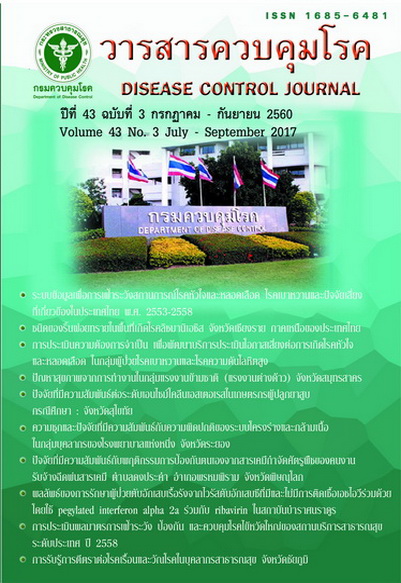Species composition of sandfly in Leishmaniasis affected foci in Chiang Rai Province Northern Thailand
DOI:
https://doi.org/10.14456/dcj.2017.12Keywords:
Leishmaniasis, Phlebotomus, SergentomyiaAbstract
This study aims to investigate the sandflies species composition. A cross-sectional survey was conducted, in three purposive selected villages where Leishmaniasis cases were previously reported in Village 4 Pa-ao-Donchai Canton, Munag District and Vil. 14 Por Canton, WeingKhan District including adjacent location where no Leishmaniasis has been reported, Vil. 11, TarnThong Canton, Phan Distrit, Chiang Rai Province. The study was carried out from August-November 2015. Sampling was conducted during three consecutive nights, using light traps, the collection time beginning after sunset 18.00 pm. - 06.00 am. The results revealed that, total of 430 sandflies were collected with 17 species of 2 genera: Sergentomyia (365/84.9%) and Phlebotomus (65/15.1%) respectively. Females were slightly collected higher than male (218:212). The sandflies were collected highest in November (300/69.8%), October (58/13.5%), August (46/10.7%) and September (26/6%) respectively. The first three most abundant species of sandflies captured were Sergentomyia punjabensis (31.2%), follow by Sergentomyia gemmea (27.2%) and Sergentomyia barraudi (8.8%) respectively. In addition, two species of the genus Phlebotomus, Phlebotomus argentipes and P. major major a known vector of Leishmaniasis were also detected. None of the captured sandflies was infected with Leishmania spp. by PCR technique. Collection sites with most collected of sand¬flies were clump of bamboos (120/430) 27.9% follow by abandoned house (80/430) 18.6% and termite hill (68/430) 15.8%. The determination of the species composition of sandfly populations, seasonal vari¬ations, relative abundances and estimations of infection in the vector population may provide information about the dynamics of leishmaniasis transmission that is useful in planning vector control activities.
Downloads
References
2. ธีรยุทธ สุขมี, สุชาดา จันทสิริยากร, กอบกาญจน์ กาญจโนภาศ.สถานการณ์โรคลิชมาเนียในประเทศไทย. รายงานการเฝ้าระวังทางระบาด
วิทยา ประจำสัปดาห์ 2554;42:260-4.
3. Apiwathnasorn C, Sucharit S, Surathin K, Deesin T. Anthropophilic and zoophilic phlebotomine sand flies (Diptera, Psychodidae) from Thailand. J Am Mosq Control Assoc 1993;9:135-7.
4. Kanjanopas K, Siripattanapipong S, Ninseang U, Hitakarun A, Jitkaew S, Kaewtaphya P, et al. Sergentomyia (Neophlebotomus) gemme, a potential vector of Leishmania siamensis in Southern Thailand. BMC Infect Dis 2013; 13:333.
5. Chusri S, Thammapalo S, Silpapojakul K, Siriyasatien P. Animal reservoirs and potential vectors of Leishmania siamensis in Southern Thailand. Southeast Asian J Trop Med Public Health 2014;45:13-9.
6. D. J. Lewis. The biology of phebotomidae in relation to leismaniasis. Annu Rev Entomol 1974;19:364-84.
7. D. J. Lewis. Phlebotomine sandflies (Diptera: Psychodidae) from the Oriental region. Syst Entomol 1987;12:163-80.
8. D. J. Lewis. The phlebotominine sandflies (Diptera: Psychodidae) of the Oriental Region. Bulletin of the British Museum (Natural History), B. Entomology 1978;37:217-343.
9. Apiwathanasorn C, Samung Y, Prummongkol S, Phayakaphon A, Panasopolkul C. Cavenicolous species of phlebotomine sand flyies from Kan¬chanaburi Province, with an updated species list for Thailand. Southeast Asian J Trop Med Public Health 2011;42:1405-9.
10. Polseela R, Jaturas N, Thanwisai A, Sing Kong- Wah, Wilson John-James. Towards monitoring the sandflies [Diptera: Psychodidae] of Thailand: DNA barcoding the sandflies of Wihan Cave, Uttaradit. Mitochodrial DNA [Internet]. 2015 [cited 2016 Oct 5]27:3795-801. Available from: www.tandfonline.com/doi/abs/10.3109/ 19401736.2015.1082085
11. Polseela R, Apiwathnasorn C, Samung Y. Sea¬sonal variation of cave-dwelling phlebotomine sandflies (Diptera: Psychodidae) in Phra
Phothi¬sat Cave, Saraburi Province, Thailand. Southeast Asian J Trop Med Public Health 2007;38: 1011-5.
12. Polseela R, Vitta A, Apiwathnasorn C. Distribu¬tion of phlebotomine sand flies (Diptera: Psy¬chodidae) in Limestone Caves Khao Pathawi, Uthai Thani Province, Thailand. Southeast Asian J Trop Med Public Health 2015;46:425-33.
13. Panthawong A, Chareonviriyaphap T, Phasuk J. Species diversity and seasonality of phlebotom¬ine sand flies (Diptera: Psychodidae) in Satun Province, Thailand. Southeast Asian J Trop Med Public Health 2015;46:857-65.
Downloads
Published
How to Cite
Issue
Section
License
Articles published in the Disease Control Journal are considered as academic work, research or analysis of the personal opinion of the authors, not the opinion of the Thailand Department of Disease Control or editorial team. The authors must be responsible for their articles.






